|
|
ARTHROPODS:
Insects»
Spiders»
Centipedes»
Millipedes»
Sowbugs»
Harvestmen»
Mites
& Ticks»
Scorpions»
Identification
Tips»
About
the Critter Files»
Links» |
|
|
|
 |
WOLF
SPIDERS
Critter
Files/Spiders/Wolf Spiders
By Blake Newton
University of Kentucky Department of Entomology |
| |
|
| Wolf Spiders
are large, hairy spiders which are usually patterned with a mixture
of black, gray, and brown. Wolf spiders, especially large
ones, look very similar to spiders in the Pisauridae family (nursery
web and fishing spiders), but commonly encountered wolf spiders are often more
robust, with shorter legs. Wolf spiders have 8 eyes. As
with all spiders, wolf spiders have 8 legs, 2 body parts (cephalothorax
and abdomen), and fang-like mouthparts called "chelicerae." |
|
 Typical Wolf
Spider (R. Bessin, 2002)
Typical Wolf
Spider (R. Bessin, 2002) |
|
| SIZE:
Body length up to about 1" |
| |
| LIFE
CYCLE |
|
Simple
metamorphosis: like all spiders, young wolf spiders hatch from eggs
and look like tiny adults when they are born. A wolf spider
sheds its skin several times as it grows to an adult. Some
wolf spiders live for several years. In many species, female
wolf spiders lay dozens of eggs at a time and wrap them in a large
ball of silk. The female will then carry the egg sac on her
abdomen until the spiderlings hatch. Upon hatching, the spiderlings
will live on the mother's back for a few weeks until they are large
enough to hunt on their own. Thanks to Greg Abernathy of Lexington,
Kentucky, who sent us the picture below. |
| |
 A female wolf
spider in the Rabidosa genus
A female wolf
spider in the Rabidosa genus
carrying young spiderlings (G. Abernathy, 2003) |
| |
| ECOLOGY |
|
Wolf spiders are active
hunters that patrol the ground for insects, small spiders, and similar
prey. They do not use webs to capture prey. Wolf spiders
are among the most commonly encountered Kentucky spiders and are found in all
corners of the state and in virtually every habitat. They
live by the thousands in leaf litter and grassy areas. Some
wolf spiders build small burrows and defend a territory, others
are free-roaming. Because they are so numerous, and such voracious
predators, wolf spiders are a very important part of any ecosystem
in which they occur. Pictured below is a wolf spider in the Hogna genus feeding on a cockroach (thanks to Michael Richichi for sending us this image).
|
| |
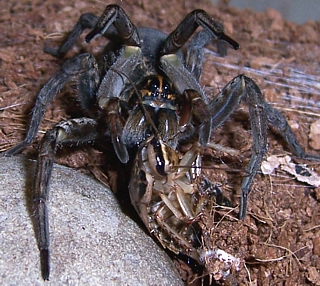 Wolf Spider in the Hogna genus feeding on a cockroach (M. Richichi, 2008)
Wolf Spider in the Hogna genus feeding on a cockroach (M. Richichi, 2008) |
| |
| PEST
STATUS |
|
In most
cases, wolf spiders benefit humans by feeding on all sorts of insects,
including crop pests. Wolf spiders are rarely pests, but they
sometimes wander into houses, where their large size often frightens
homeowners. Wolf spiders can bite, but their bites are extremely
rare and no more dangerous or painful than bee stings. In
fact, bees and wasps are more dangerous than wolf spiders because
a wolf spider will never "attack" a person, unlike bees
or wasps that will attack to defend a hive. Wolf spiders will
only bite if they are mishandled. Wolf spiders that are found
indoors have wandered in by mistake and should be collected and
released outdoors (if you ever need to collect a wolf spider, "herd"
the spider into a container with a stick or a pencil).
CONFUSION: Wolf
Spider vs. Brown Recluse
Because wolf spiders are sometimes seen indoors and because they
are often brown in color, they are often mistaken for brown recluse
spiders. If you see a fast-moving, dark-colored spider running
on the floor, it is more likely to be a wolf spider than a brown
recluse. Brown recluses are very secretive and are almost
never seen out in the open. With a little practice, it is
easy to tell the difference between wolf spiders and brown recluses.
Take a look at the Case
File for Brown Recluses, and our Brown
Recluse ENTfact to learn how to identify brown recluse spiders.
|
| |
| COMMON
KENTUCKY WOLF SPIDERS |
|
| There are
many wolf spider species in Kentucky, but most of them look very similar
and are difficult to identify to species, even for experts. Shown
below are some common examples. |
|
|
Hogna
spp.
GENUS: Hogna
Pictured
below are wolf spiders in the Hogna genus.
This genus contains some of the largest wolf spiders in Kentucky,
with body lengths up to about 1". (Note that many Kentucky
wolf spiders currently in the genus Hogna were once part
of the genus Lycosa, but this was changed in recent years). |
|
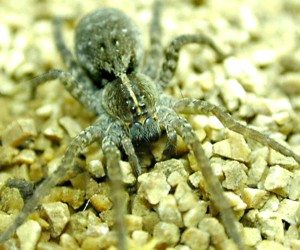 Wolf Spider in
the Hogna genus (B. Newton, 2002)
Wolf Spider in
the Hogna genus (B. Newton, 2002) |
|
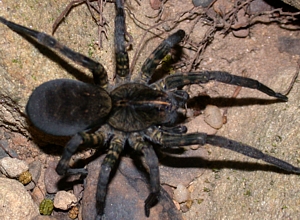 Wolf Spider in
the Hogna genus (B. Newton, 2005)
Wolf Spider in
the Hogna genus (B. Newton, 2005) |
|
|
|
Rabid
Wolf Spider
GENUS and SPECIES:
Rabidosa rabida
The Rabid
Wolf Spider, Rabidosa rabida, is a typical member
of the wolf spider genus Rabidosa. Wolf spiders in
this genus are very common in Kentucky and grow to about 1"
in length. They are characterized by bold brown and white
stripes on the cephalothorax. The picture of the female wolf
spider carrying spiderlings (shown above)
is also in the genus Rabidosa. |
|
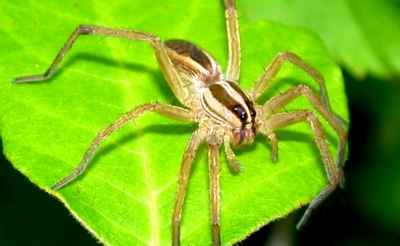 The Rabid Wolf
Spider, Rabidosa rabida (B. Newton, 2005)
The Rabid Wolf
Spider, Rabidosa rabida (B. Newton, 2005) |
|
|
|
Schizocosa
spp.
GENUS: Schizocosa
Members of the genus Schizocosa
are among the smallest wolf spiders in Kentucky, with a body length
that rarely exceeds 1/4". They are also some of the most
common wolf spiders, especially in meadows and leaf litter where
they prey on springtails and other small insects. The one
pictured below is carrying an egg sac, a behavior exhibited by most
female wolf spiders. |
|
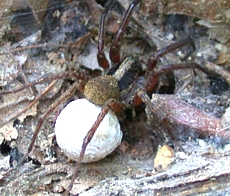 A female wolf
spider in the Schizocosa
A female wolf
spider in the Schizocosa
genus with an egg sac (B. Newton, 2004) |
|
| |
| COLLECTING
& PHOTOGRAPHY |
|
Wolf spiders are almost
always be found close to the ground. Look for them under rocks
and logs, near streams, in leaf litter, on the forest floor, at
the bases of cultivated plants, and just about anyplace else (they
are extremely common). They are often the same color as their
background, so they can be very hard to see. Wolf spiders
are very fast, so you have to be fast too if you want to catch one
(or its picture - use a fast film speed and bright light to get
a good picture of a wolf spider).
Wolf spiders can deliver
a painful bite, so they should never be picked up by hand. Instead,
if you ever need to collect a wolf spider, "herd" the
spider into a container with a stick or a pencil. Like all
spiders, wolf spiders should be preserved in ethyl alcohol.
Captive Wolf
Spiders: large wolf spiders will do well in captivity when
properly cared for. For tips, visit our page:
Pet Bugs - Wolf Spiders. |
| |
| MYTHS
- LEGENDS - FOLKLORE |
|
Wolf spiders probably
got their name from the way that they catch their prey. Instead
of catching prey in a web, wolf spiders stalk and chase their prey like a wolf. In addition, the root word "lycos"
in "Lycosidae" (the scientific family name for wolf spiders)
is Greek for "wolf." The name has been around for
a long time: the ancient Greek writer and philosopher Aristotle
mentioned the "wolf spider" in his History of Animals,
written in 350 BC.
Although wolf spiders
resemble tarantulas, they are not closely related. Despite
this, at least one species of wolf spider, Hogna tarantula
(a.k.a. Lycosa tarantula), a large wolf spider that lives
in Italy, is referred to as the "Tarantula Spider." Long ago, these wolf spiders were blamed for causing a disease
called "tarantism," the treatment of which involved a
special dance called the "tarantella." As it turns
out, the bite of this spider is no more dangerous than a bite from
any other wolf spider. You can read more about the Italian "tarantula"
wolf spider at this page from Wikipedia:
http://en.wikipedia.org/wiki/Lycosa_tarentula
Do you know any other
myths, legends, or folklore about wolf spiders? If so, let
us know.
|
| |
Original document: 25 May 2004
Last updated: 30 Jan 2008
Photos courtesy R.
Bessin and B. Newton, University of Kentucky
The Kentucky Critter Files are maintained
by Blake Newton, Department of Entomology, University of Kentucky.
Contact: blaken@uky.edu |
|

